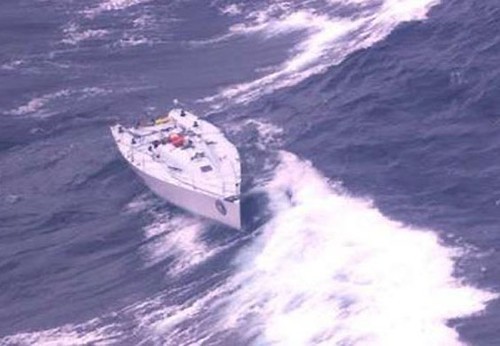Rolex Sydney Hobart 1998 to 2008- How things have changed
by Nancy Knudsen on 24 Dec 2008

Sword of Orion 1998 SW
It's just 10 years since the horrific 1998 Sydney to Hobart race, and on the eve of the 2008 race it's time to wonder if such a tragedy could happen again. 115 yachts started that year of the 54th annual Sydney to Hobart Yacht Race. When an intense low pressure system hit the fleet in Northern Bass Strait, only 44 boats made it to Hobart, five boats sank, 66 boats retired from the race, six sailors died and 55 sailors were rescued from their yachts, most by helicopter.
Rob Kothe’s Sword of Orion was one of the boats that sailed in that fateful race and I asked him just what has changed in the ten years.
'If the 2008 fleet were to experience the savage Bass Strait conditions we faced in 1998 the outcome would be very different.' he said. 'Today sailors can access better weather forecasts, and all the available data has also improved.
'In 1998, by the time we were closing in on the original low pressure cell in southern Bass Strait, which we were warned about before leaving Sydney, the cell was well on its way to New Zealand. Conditions should have been rapidly easing. 'But they were not, and we did not know why.
'Much later, at the inquest, we saw the full details of the Weather Bureau’s tracking of the new and fatal intense low pressure cell coming across from north western tip of Tasmania to the top of Bass Strait.
'Sadly the Sydney to Hobart fleet receiving the Weather Bureau’s official Sydney to Hobart forecast did not hear about this new cell and the midday Day 2 forecast was way off and we were one of a number of boats that turned back north into the very worst of this new low pressure cell. '
'Detailed meteorological data via satellite these days means this would be much less likely to happen today, and boats are not nearly as reliant on forecasters.
'The rules of racing have also changed as a result of what happened in 1998:
'At the 12:30pm sked on Dec 27th 1998, the weather forecast read out by race control was winds up to 50 knots.
'On Sword of Orion we were experiencing 78 knots . Under racing rules we could not tell anyone, because we weren’t allowed to give other boats assistance by informing them of the weather ahead.
'We decided this was a life and death situation; it was not a game. We broke the rules to report to the wind strengths to the fleet, which soon reached 92 knots .
'It was too late to warn everyone. Many boats were close behind us, but about 40 boats retired to Eden as a result of our actions.
'Under today’s more sensible rules wind speeds above 40 knots have to be reported; therefore sudden unpredicted storm cells will not catch everyone unawares.
'Across the board, the equipment has improved, including better lifejackets, better harnesses, personal EPIRBS. There's also much better education and training. Better weather data and a change in the mind set of Race officials and race participants have made the biggest change, but all these moves have made racing safer.
'The sad fact is that if one person had died in every second Hobart race, for a decade, , the major overhaul that followed the six tragic deaths in 1998 would not have occurred.
'The response by yachting authorities after the 1998 Hobart race has made offshore sailing around the world safer. Many lives have been saved and many more will be saved in the future.'
This does not mean that skippers or their crews can relax their guard in the area of safety. New rules are only good if they are followed, the ocean is always the master, and skippers, ultimately, are responsible for their yacht's safety. It does mean that the tools at hand are superior, and knowledge and expertise generally higher.
The six sailors who died during the 1998 Sydney to Hobart Race were Phillip Charles Skeggs (Business Post Naiad), Bruce Raymond Guy (Business Post Naiad), John Dean, James Lawler and Michael Bannister (all on the Winston Churchill),and Glyn Charles (Sword of Orion).
Sailors in the 2008 Hobart Race will once again pay their respects to them at the Memorial Service in Hobart, after the 2008 race, just as they did a decade ago.
If you want to link to this article then please use this URL: www.sail-world.com/52161